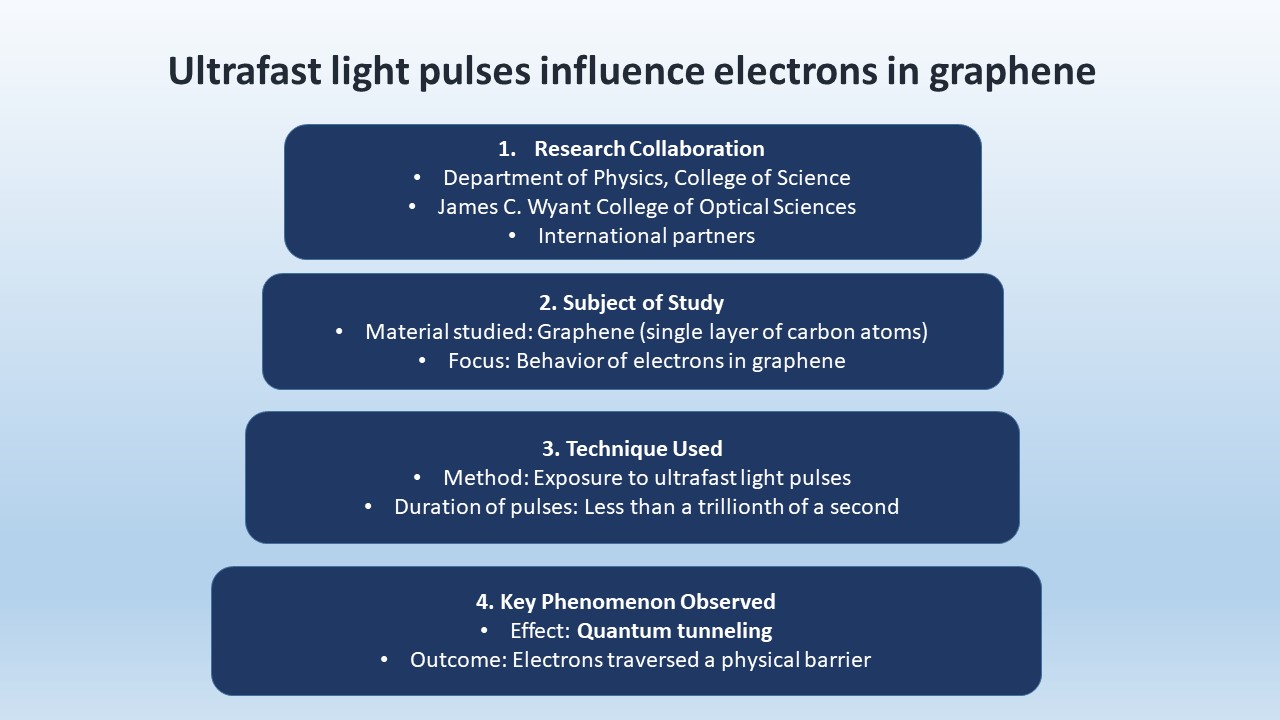University of Arizona researchers helped develop a light-based graphene transistor that could enable petahertz-speed computing.

Researchers, including a team from the University of Arizona, are investigating the use of ultrafast light pulses as a potential method to increase computing speeds beyond current processor capabilities.
The University of Arizona is a Research 1 institution and AAU member, supporting student success, a $1B research enterprise, and partnerships across disciplines and communities.
In an international collaboration, researchers from the Department of Physics in the College of Science and the James C. Wyant College of Optical Sciences demonstrated that electrons in graphene can be influenced by ultrafast light pulses lasting less than a trillionth of a second. Using a quantum effect known as tunneling, they observed electrons traversing a physical barrier on extremely short timescales, with potential implications for the development of faster computing technologies.
A study published in Nature Communications reports that the technique may enable processing speeds in the petahertz range, which is significantly faster than current computer chip capabilities.
“Sending data at those speeds would revolutionize computing as we know it,” said Mohammed Hassan, an associate professor of physics and optical sciences. Hassan has long pursued light-based computer technology and previously contributed to the development of an advanced electron microscope.
“We have experienced a huge leap forward in the development of technologies like artificial intelligence software, but the speed of hardware development does not move as quickly,” Hassan said. “But, by leaning on the discovery of quantum computers, we can develop hardware that matches the current revolution in information technology software. Ultrafast computers will greatly assist discoveries in space research, chemistry, health care and more.”
Hassan worked alongside U of A colleagues Nikolay Golubev, an assistant professor of physics; Mohamed Sennary, a graduate student studying optics and physics; Jalil Shah, a postdoctoral scholar of physics; and Mingrui Yuan, an optics graduate student. They were joined by colleagues from the California Institute of Technology’s Jet Propulsion Laboratory and the Ludwig Maximilian University of Munich in Germany.
The team was initially studying the electrical conductivity of modified graphene samples, a material made of a single layer of carbon atoms. When a laser is directed at graphene, its energy excites electrons in the material, causing them to move and generate a current.
Sometimes, the electric currents cancel each other out. Hassan explained that this occurs because the laser’s energy oscillates, producing equal and opposite currents on either side of the graphene. Due to graphene’s symmetrical atomic structure, these currents reflect each other and cancel out, resulting in no measurable current.
What if a single electron could pass through graphene and its movement could be observed in real time? The team observed this near-instant “tunneling” effect after modifying different graphene samples.
“That is what I love most about science: The real discovery comes from the things you don’t expect to happen,” Hassan said. “Going into the lab, you always anticipate what will happen – but the real beauty of science are the little things that happen, which lead you to investigate more. Once we realized that we had achieved this tunneling effect, we had to find out more.”
Using a commercially available graphene phototransistor modified with a silicon layer, the researchers used a laser pulsing at 638 attoseconds to demonstrate a quantum transistor operating at petahertz frequencies.
A transistor is an electronic component that functions as a switch or amplifier, regulating the flow of electrical current between two points. It is a basic building block in electronics circuits.
“For reference, a single attosecond is one-quintillionth of a second,” Hassan said. “That means that this achievement represents a big leap forward in the development of ultrafast computer technologies by realizing a petahertz-speed transistor.”
While many experimental devices require controlled environments such as low temperature or high vacuum, this transistor operated successfully under ambient conditions, suggesting potential for future application in practical electronic systems.
Hassan is collaborating with Tech Launch Arizona, the office that assists researchers in patenting and potentially commercializing technologies developed at the University of Arizona. While the original transistor required a specialized laser, the team is now working on a version that can operate with standard, commercially available equipment.
“I hope we can collaborate with industry partners to realize this petahertz-speed transistor on a microchip,” Hassan said. “The University of Arizona is already known for the world’s fastest electron microscope, and we would like to also be known for the first petahertz-speed transistor.”
Edited by Puja Mitra, WTWH Media, for Control Engineering, from a University of Arizona news release.



